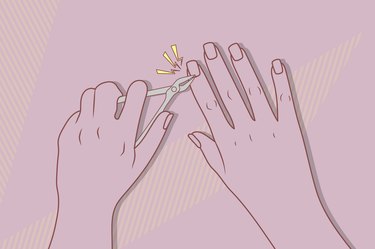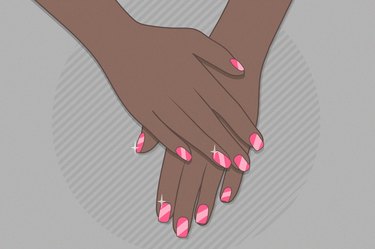
Psoriatic arthritis is a type of arthritis that affects some people who have psoriasis, a skin condition thought to be an autoimmune disorder. Psoriasis occurs when your immune system attacks your skin, and psoriatic arthritis happens when your immune system attacks your joints and connective tissues, according to the Cleveland Clinic.
Not everyone with psoriasis has psoriatic arthritis, and it's even possible to have psoriatic arthritis without psoriasis.
Video of the Day
Video of the Day
The Centers for Disease Control and Prevention says psoriatic arthritis affects up to 20 percent of people with psoriasis, though some studies put that number as high as one-third, according to March 2019 research in the Journal of Dermatological Treatment.
While psoriasis is mostly known for how it affects the skin, those who develop psoriatic arthritis often experience symptoms related to the nails sometimes called nail involvement or nail psoriasis.
If you suspect you have psoriatic arthritis with nail involvement, a rheumatologist or dermatologist can help you manage your symptoms and recommend the right treatment. Here's a glimpse into what you can expect and do.
First, What Is Nail Psoriasis?
When psoriasis affects your nails, it's called nail psoriasis, per the American Academy of Dermatology (AAD). It's sometimes called psoriasis of the nails, and it can cause changes to both your fingernails and toenails. As few as one nail or as many as all of them may be affected.
"Nail psoriasis is when the nails have psoriatic disease and can present symptoms like pitting, separation and thickening under the nail," explains Dana Stern, MD, a board-certified dermatologist in New York who specializes in nail diseases.
Nail psoriasis and psoriatic arthritis are not the same thing, but they can co-exist and overlap. Around 80 percent of people with psoriatic arthritis have nail involvement, according to the National Psoriasis Foundation. Nail psoriasis is one of the most common signs and symptoms of psoriatic arthritis. "Sometimes the hands have both nail psoriasis and psoriatic arthritis," Dr. Stern says.
5 Ways Psoriatic Arthritis Can Change Your Nails
Changes to your nails are some of the most common indicators of psoriatic arthritis, but it requires a doctor to diagnose because the symptoms overlap with other skin and nail conditions like eczema.
"Psoriatic arthritis can have a slow, somewhat insidious onset or it can develop acutely and severely," says Dr. Stern. "If you suspect you have psoriatic arthritis, see a board-certified rheumatologist, who will take a thorough history, perform a detailed examination and likely look at blood work and some kind of imaging study."
Here are some of the signs of nail psoriasis caused by psoriasis or psoriatic arthritis to look out for. If you notice any of these, it may be time to see your doctor.
1. Pitting
Pitting is one of the most common signs of nail psoriasis, affecting up to 68 percent of people with psoriasis-related nail changes, per a July 2017 article in Reumatologia, who also notes that it's the most common symptom of psoriatic arthritis.
Pitting refers to superficial depressions in the nail itself. It can look like dents, grooves or ridges. In some cases, shallow or deep holes may develop.
Keep in mind there are other reasons for nail pitting — for example, it can be a sign of vitamin deficiencies in the nails.
2. Discoloration
Nail psoriasis can cause your nail bed — the skin under the nail — to change colors. They're sometimes called oil drop spots or salmon patches, per the Cleveland Clinic, which notes that nails may appear yellow, red, pink or brown.
Discoloration may also be white, per the AAD. (This is different from white lines on nails, though.)
3. Separation
Nail separation or lifting, also known as onycholysis, occurs when the nail plate detaches from the nail bed. This forms a pocket of space between the nail plate and bed where bacteria could potentially settle, increasing the risk of infection.
4. Subungual Hyperkeratosis
"Subungual" means under the fingernails or toenails and "hyperkeratosis" refers to the thickening of skin caused by excess layers of keratin. Together, subungual hyperkeratosis is the thickening of the nail bed. It looks like the buildup of a white, chalky substance under the nails and can be particularly uncomfortable when wearing shoes.
5. Fungal Infections
A common misconception is that nail psoriasis is a type of fungus. While it's not a fungus, a fungal infection known as onychomycosis, which causes the nails to thicken and appear crumbly, can happen alongside nail psoriasis.
In fact, it's quite common, affecting an estimated 35 percent of people with nail psoriasis, according to the Psoriasis and Psoriatic Arthritis Alliance.
Researchers think psoriatic nail changes make it easier for this type of nail fungus to settle in, per a May 2020 study in Dermatology Research and Practice.
The fungal infection can be treated, but the treatment doesn't cure the actual nail psoriasis.
How to Treat Nail Psoriasis
There is no cure for psoriatic arthritis (although there are natural remedies for arthritis pain relief you can add to your treatment plan). Just like joint and skin symptoms, the goal is to control nail psoriasis as much as possible.
Treatments typically include oral anti-inflammatory medications and various injections, Dr. Stern notes. Usually, a corticosteroid is involved, per the AAD, which can be administered topically, orally or by injection.
Other options include oral medications derived from vitamins A and D, light therapy, laser therapy and other topical creams and ointments.
If you suspect your nail-related changes are caused by psoriatic arthritis, don't wait to seek treatment. "Psoriatic arthritis can be progressive and destructive to the joints if it is not treated," says Dr. Stern. "Researchers have made major strides in developing effective therapies that can halt the disease process and progression in recent years."
Still, treating nail psoriasis stemming from psoriatic arthritis isn't easy. Treatment for nail psoriasis is challenging because it's resistant to therapy, according to a June 2021 review in Dermatology and Therapy. Ultimately, researchers recommend a personalized approach for each individual, and a combination of two or more therapies may be needed.
It also takes several months to see improvements because nails grow slowly.
Nail Care Tips
Nail psoriasis is best treated by a doctor, but there are also ways you can care for your nails at home. The following is recommended in addition to your doctor's prescribed treatment, per the AAD:
- Keep your nails short, clean and dry
- Use hand moisturizer after washing your hands and bathing
- Wear gloves when working with your hands
- Avoid artificial nails and aggressive manicures
- Don't bite your nails
- Avoid picking at your nails or cuticles
- Let buildup clear on its own — don't scrape at it
- Cleveland Clinic: "How Does Psoriatic Arthritis Affect Your Nails?"
- Centers for Disease Control and Prevention: “Psoriasis”
- Journal of Dermatological Treatment: “Psoriatic arthritis for dermatologists”
- National Psoriasis Foundation: “What Your Nails Can Tell Your Doctor About PsA”
- Cleveland Clinic: “Nail Psoriasis”
- Psoriasis and Psoriatic Arthritis Alliance: “Psoriasis in the nails”
- Dermatology Research and Practice: “Onychomycosis in Psoriatic Patients with Nail Disorders: Aetiological Agents and Immunosuppressive Therapy”
- Reumatologia: “Nail involvement in psoriatic arthritis”
- Dermatology and Therapy: “Nail Psoriasis: A Review of Effective Therapies and Recommendations for Management”
- American Academy of Dermatology: “7 nail care tips that can reduce nail psoriasis”
Is this an emergency? If you are experiencing serious medical symptoms, please see the National Library of Medicine’s list of signs you need emergency medical attention or call 911.


